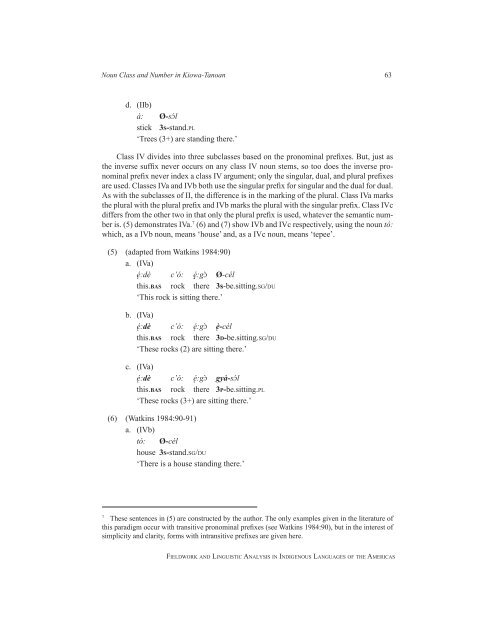Fieldwork and Linguistic Analysis in Indigenous ... - ScholarSpace
Fieldwork and Linguistic Analysis in Indigenous ... - ScholarSpace
Fieldwork and Linguistic Analysis in Indigenous ... - ScholarSpace
Create successful ePaper yourself
Turn your PDF publications into a flip-book with our unique Google optimized e-Paper software.
Noun Class <strong>and</strong> Number <strong>in</strong> Kiowa-Tanoan 63<br />
d. (IIb)<br />
á: Ø-sɔ́l<br />
stick 3S-st<strong>and</strong>.Pl<br />
‘Trees (3+) are st<strong>and</strong><strong>in</strong>g there.’<br />
Class IV divides <strong>in</strong>to three subclasses based on the pronom<strong>in</strong>al prefixes. But, just as<br />
the <strong>in</strong>verse suffix never occurs on any class IV noun stems, so too does the <strong>in</strong>verse pronom<strong>in</strong>al<br />
prefix never <strong>in</strong>dex a class IV argument; only the s<strong>in</strong>gular, dual, <strong>and</strong> plural prefixes<br />
are used. Classes IVa <strong>and</strong> IVb both use the s<strong>in</strong>gular prefix for s<strong>in</strong>gular <strong>and</strong> the dual for dual.<br />
As with the subclasses of II, the difference is <strong>in</strong> the mark<strong>in</strong>g of the plural. Class IVa marks<br />
the plural with the plural prefix <strong>and</strong> IVb marks the plural with the s<strong>in</strong>gular prefix. Class IVc<br />
differs from the other two <strong>in</strong> that only the plural prefix is used, whatever the semantic number<br />
is. (5) demonstrates IVa. 7 (6) <strong>and</strong> (7) show IVb <strong>and</strong> IVc respectively, us<strong>in</strong>g the noun tó:<br />
which, as a IVb noun, means ‘house’ <strong>and</strong>, as a IVc noun, means ‘tepee’.<br />
(5) (adapted from Watk<strong>in</strong>s 1984:90)<br />
a. (IVa)<br />
ę́:dè c’ó: ę̨́:gɔ̀<br />
Ø-cél<br />
this.BAS rock there 3s-be.sitt<strong>in</strong>g.sg/du<br />
‘This rock is sitt<strong>in</strong>g there.’<br />
b. (IVa)<br />
ę́:dè c’ó: ę́:gɔ̀ ę̀-cél<br />
this.BAS rock there 3D-be.sitt<strong>in</strong>g.sg/du<br />
‘These rocks (2) are sitt<strong>in</strong>g there.’<br />
c. (IVa)<br />
ę́:dè c’ó: ę́:gɔ̀ gyà-sɔ́l<br />
this.BAS rock there 3P-be.sitt<strong>in</strong>g.Pl<br />
‘These rocks (3+) are sitt<strong>in</strong>g there.’<br />
(6) (Watk<strong>in</strong>s 1984:90-91)<br />
a. (IVb)<br />
tó: Ø-cél<br />
house 3S-st<strong>and</strong>.sg/du<br />
‘There is a house st<strong>and</strong><strong>in</strong>g there.’<br />
7 These sentences <strong>in</strong> (5) are constructed by the author. The only examples given <strong>in</strong> the literature of<br />
this paradigm occur with transitive pronom<strong>in</strong>al prefixes (see Watk<strong>in</strong>s 1984:90), but <strong>in</strong> the <strong>in</strong>terest of<br />
simplicity <strong>and</strong> clarity, forms with <strong>in</strong>transitive prefixes are given here.<br />
fieldwork <strong>and</strong> l<strong>in</strong>guistic analysis <strong>in</strong> <strong>in</strong>digenous languages of the americas

















